In the frame of the HERA luminosity upgrade program,
the present performance of the HERA preinjectors has been studied
in detail. Upgrading the proton linac (Linac III) energy
from 50 MeV to 160 MeV is one possibility currently
under discussion to obtain higher luminosity. Taking into account
the limited space between the existing setup and the injection
beam line to the DESY III, DESY's proton synchrotron, an
upgrade study of an 810 MHz linac has been carried out. The
results are summarized in this paper and some aspects are discussed
leading to the solution presented here.
The present transport channel from Linac III to the synchrotron is long enough in order to use the straight beam line downstream of the last tank of the Drift Tube Linac (DTL) for installation of additional accelerating structures in order to upgrade the energy of the H¯ linac. According to our study a frequency of 810.24 MHz should be used for the upgraded part. Using four times the frequency of the 50 MeV Alvarez linac allows to obtain a high accelerating gradient which accelerates the H beam up to 160 MeV over a distance of approximately 33 m. A higher injection energy could be a remedy against beam emittance blow-up in the DESY Synchrotron and finally would allow beams with higher brightness in HERA.
Using existing diagnostic equipment in the Linac, both the longitudinal and transverse emittances have been reconstructed by measuring the momentum spread and beam profiles [1,2,3]. In order to estimate the full emittance an elliptical symmetry for lines with constant density in phase space has been assumed. The final values of the measured emittances, which have been used for the design of the upgraded linac part as well as the main beam characteristics of the LINAC III are presented in the Table 1.
In the energy range to be considered which in this
case is greater than 50 MeV no efficient accelerating structures
other than DTL's existed so far. However recent studies carried
out mainly at Los Alamos Laboratories resulted in the development
of accelerating structures for intermediate energies of light
ions between 20 to 100 MeV [4]. The structure is a combination
of the Coupled Cell Structure (CCS) and DTL - CCDTL. Careful studies
of the beam dynamics show that even for the 50 MeV beam with the
characteristics listed in Table 1, an operating frequency for
a CCDTL four times higher as compared to the Linac III frequency
is appropriate. The use of a 810 MHz structure allows to
achieve a high accelerating gain. In addition 810 MHz klystrons
are available (e.g. supplied by LITTON) as with small modifications
as compared to the 805 MHz klystrons which have been developed
for the Fermilab linac upgrade [5]. Also the modulator system
could be very similar to the Fermilab design [5] except for the
average power which is 30 times smaller.
| Table 1: Linac III beam parameters | |
| Repetition rate, Hz | |
| Pulse length, s | |
| Pulse current, mA | |
| Energy, MeV | |
| Emittance: | |
| Long. (-S, W/W) | |
| , deg./% | |
| l ,eff, deg%, rms | |
| 90% | |
| ~100% | |
| Horizontal&Vertical | |
| x | |
| x , mm/mrad | |
| x, mmmrad, rms | |
| 90% | |
| ~100% | |
| y | |
| y , mm/mrad | |
| y, mmmrad, rms | |
| 90% | |
| ~100% | |
Providing a high accelerating gradient and the use of the fourth harmonic on the other hand results in some disadvantages which must be taken into account:
Both transverse and longitudinal motions of the particles require a transition region (TR) at the output of the present DTL. Using a 12 MW klystron the upgraded part of Linac must be divided into three parts. Each part is powered by a separate klystron. With one CCDTL part an energy gain of approximately 40 MeV can be achieved while the other two parts are based on a more conventional CCS. Considering in addition proper beam focusing results in 10 accelerating sections with constant phase velocity and 9 coupling bridges in the CCDTL part and 6 accelerating sections and 5 bridges in each CCS part. The quadrupole lenses are placed between the sections as well as the cavities to provide a FODO lattice. The design of the CCS has been made, taking into account that each accelerating section consists of 16 cells each.
Special attention has been given to the distance
between the sections. It is obvious that this length must be as
small as possible from the requirements determined by the longitudinal
beam motion. In practice this distance is chosen according to
the design of the focusing lenses which are installed in between,
as well as steering magnets and beam instrumentation required
at these places. For linacs operating today which are based on
the CCS, this space is an odd multiple of /2 and the shortest
length of 3/2 has been realized for example in the upgraded Fermilab
linac. In the energy range between 50 to 100 MeV this value is
not sufficient to fit the equipment mentioned before and we decided
to choose the inter-section distance in the CCDTL cavity equal
to 2 while for the CCL this distance is 3/2. Rectangular coupling
bridges operating in a TE11n mode are planned for coupling of
accelerating sections in each part. This type of bridge has been
successfully applied in the main part of INR linac [6]. The TE11n
bridge avoids mode mixing, provide the space needed for equipment
and can provide either or 2 phase shift between accelerating sections.
The well known Side Coupled Structure (SCS) could be a good solution for the Linac Upgrade. However relatively large number of cells in the CCL sections (96) require strong coupling (> 5-7 %), which is more than typically used for the SCS. The use of a SCS in the CCDTL would result in even smaller coupling (~1%). On the other hand the Disk and Washer (DAW) structure can be used for this purpose. Nevertheless, for a comparativley short linac (272 accelerating gaps in total), the development and production cost for DAW structure is higher as compared to the CCSs. In addition a DAWDTL has not been studied in detail and preliminary studies show that more interfering modes exist. Methods to remove parasitic modes from the vicinity of the operating mode, which have been developed for standard DAW structures, are not evidently effective in DAWDTL and need more detailed analysis.
An On-axis Coupled Structure (OCS) was chosen in order to provide a larger coupling constant. In addition this structure is comparatively simple from the mechanical point of view and with the low repetition rate (heat load of the structure is only 60 W/m) it is not necessary to use internal cooling of the accelerating cells. A sketch of the OCS and OCSDTL is shown in Figure 1 and 2.
An OCS has been used already in many electron machines. For the upgrade we have studied and optimized the On-axis Coupled Structure for cells, which are used in the velocity range of 0.3<<0.52, with the 2D/3D MAFIA code [7].
A few key points have been taken into account:
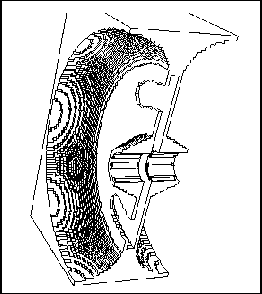
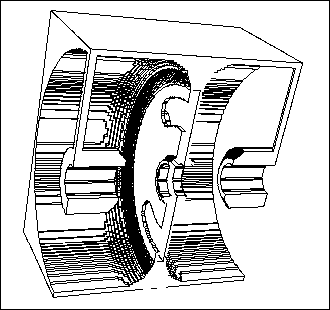
The calculated values of ZT2 , taking some degradation
into account and E0T for the finally chosen option of the OCSDTL
and OCS are plotted in Figure 3.
The accelerating structure geometry has been modeled using functions of the effective accelerating gradient E0T, effective shunt resistance ZT2 and the gap ratio ag with respect to the relative beam velocity b, as being obtained from the MAFIA calculations. A general parameter list of the upgraded Linac is given in the Table 2.
Due to the different periodicity of the focusing structure in section 1 (16bl) and section 2 (19bl), matching of the transverse beam dimensions is necessary between these two sections. This is provided using four quadrupole lenses at the end of the cavity 1.
The main component of the transition region (TR)
is a buncher cavity followed by a drift space in order to reduce
the phase spread of the 202.56 MHz bunches from 13 to 4 as is
required for the matching conditions at the entrance of the upgraded
linac. The TR contains four quadrupoles to match the transverse
phase space parameters.
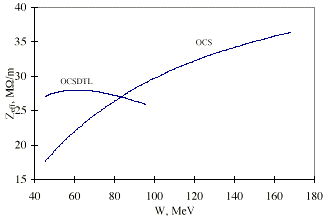
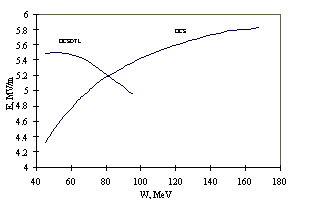
Table 2: General parameters of the upgraded linac
| Parameter | Cavity 1 | Cavity 2 | Cavity 3 |
| Initial kinetic energy, MeV | |||
| Final kinetic energy, MeV | |||
| Total length, m | |||
| Frequency, MHz | |||
| Synchronous phase | |||
| Number of sections | |||
| Number of cells per section | |||
| Type of structure | |||
| Focusing structure | |||
| Section separation, bl | |||
| Section length, bl | |||
| Length of focus. period, bl | |||
| Cavity bore radius, cm | |||
| Power consumption, MW | |||
In Figure 4 the beam envelopes (x-plane = solid line, y-plane = dashed line), the relative energy spread DW/W and the phase spread Dj of 90% of the particles are presented along the longitudinal coordinate for the upgraded part of the linac. The simulation has been performed for all 100% particles including a beam halo. The beam losses are less than 0.04%. An rms-emittance growth of 22 % in the transverse phase planes due to the rf defocusing has been calculated.
Several sources of accelerator imperfections and their effect on beam dynamics have been studied. The conventional random deviation of linac parameters from the design values produce a transverse rms-emittance growth of 20 % and a longitudinal rms emittance growth of 3 % with a probability of 90%. Two other sources of accelerating field distortions in a long CCS cavity are:
The latter slightly increases the momentum spread
of a 20 mA beam for a very short part of the beam pulse.
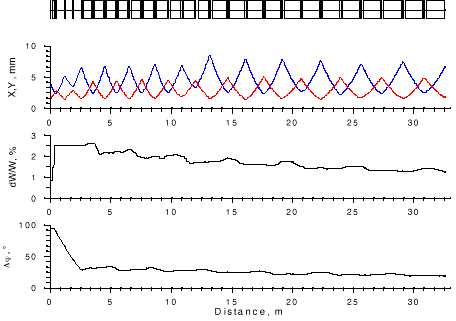
[1] Linac III Group. Project study for the 50 MeV HERA LINAC as H injector for DESY III , DESY HERA 84 - 12, 1984.
[2] L.Criegee. The 50 MeV H- Beam Transport Line. PLIN - Note 89-08, 1989.
[3]Yu.V.Bylinsky and P.N.Ostroumov. 50 MeV Linac Beam Parameters. DESY Report, February, 1996.
[4]J.H. Billen et al. A New rf Structure for Intermediate-Velocity Particles. Proc. of the 1994 Linac Conf., p. 341, 1994.
[5]Fermilab Linac Upgrade Conceptual Design Report, FNAL, November 1989.
[6] V.G. Andreev et al. The test results of the experimental module of the second part of the meson factory linac. Proc. RTI AS USSR, Moscow, No. 25, 1976.
[7] L.V.Kravchuk, V.V. Paramonov. The On-Axis Accelerating Structure for Proton Linacs with Moderate Heat Loading. This proceedings.